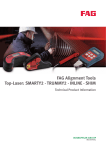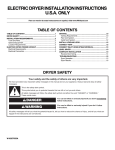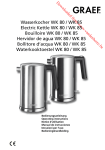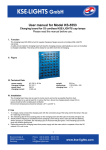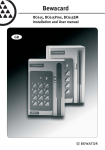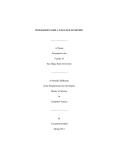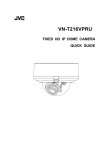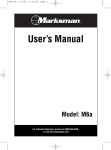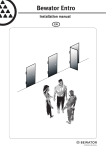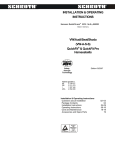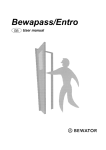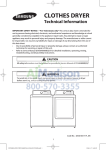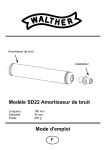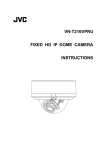Download SSP News - Walther
Transcript
SSP News ® NEWS Page 2 Stripping Page 4 Cleaning and Care of the pistol Page 5 Assembling Page 8 Trigger mechanism Page 11 Notes Page 1 Stripping the pistol How do I strip and clean my SSP? 2. There are two little black screws with small boreholes under the muzzle. These so called choke-screws can be fully unscrewed with a 2mm Allen wrench. It is important that the screws do not get mixed up. Therefore the screws can be easily distinguished by turned-in rings at the front. First of all, we would suggest that the SSP does not belong to those kinds of arms which perform better without cleaning. For some reason it is said that those arms - and a few marksmen believe this - exist! But seriously, in order to preserve its technical superiority, the SSP needs to be cleaned regularly. Depending on the kind of ammunition used, the SSP should be cleaned every 1000-2000 shots. With the wide range of .22 ammunition available, the final choice rests with the shooter who will evaluate accuracy, functioning and reliable operation of the pistol For a major cleaning, the pistol needs to be stripped down to its main components. This should be done step-by-step. 3. Release and remove the cover screw (silvercolored, 4mm Allen wrench), which is positioned under the muzzle (viewed from the front). 1. Open the slide, remove the magazine and make sure that there are no more cartridges in the chamber. 4. Employ the stripping and assembly aid from the front and lock it with the bayonet slide. In do- Page 2 Stripping the pistol ing so, the slide moves slightly backwards so that it is quite easy to remove it. The springs remain in the housing of the pistol. 7. After releasing and removing the stripping and assembly aid, push the heads of the spring rods through the boreholes. Remember that the springs on the rods are still under tension. 5. Now it is possible to pull off the whole barrel and slide system to the front. 6. Once the pistol is stripped like that, it is quite easy to remove the slide and to push out its striker. 8. Unscrew and remove the whole sight. Page 3 Cleaning and Care of the pistol Cleaning and Assembling Cleaning and Care It is really important to clean all those areas where the dirt could possibly obstruct the barrel of the striker. These include the running groove on the inside of the slide, the striker and the boreholes in the slide housing. (It is quite helpful to use a discarded toothbrush for this job). An oil film for completion is good; however, it needs to be non-resonating or non-agglutinative oil. You can produce a sufficient oil film by simply rubbing the components with an oily cloth. Page 4 Furthermore, the clean boreholes of the slide springs should be lubricated with the enclosed special grease. You put a little of the grease onto a long stemmed brush and then you push it back and forth in the borehole. Also important, the chamber should be cleaned from any dirt residues by using a lightly oiled brass wire brush. Cleaning and Care of the pistol Assembling the pistol Pay attention to the fact that the metallic-colored long spring belongs to the rod with the o-ring (slide spring rod). This rod should be positioned on the right side (viewed in shooting direction / the pictured pistol is upside down) The short blue spring is the striker spring and belongs to the left borehole. Both spring rods should be inserted and extruded from the front until they protrude at the other side of the borehole. Then simply release; the spring rods will stay in the housing of the pistol! Now we are reaching a very important aspect: BEFORE assembling the cleaned and oiled slide housing to the frame, SECURE THE SLIDE COMPLETELY, while the fit-up-aid remains at the upper part. In case of not doing so, the slide housing cannot be pushed to the stop of the frame. An opening would remain. There is the possibility to put it off and tighten the slide just then. However, as soon as the opening is closed by screwing the cover screw, parts of the trigger are ruined! Then you definitely need to call on the help of WALTHER`s repairing station or of your gunsmith. After the fitting of the upper part, remove the fit-up-aid and put both choke-screws (don`t mix them up!) back in. Then you can secure the upper part onto the bottom part by using the cover screw. Insert the striker in the slide. Push back, lock and implant the slide with the striker from the top by using the fit-up-aid as described above. WALTHER`s Service Section wishes you a lot of fun with your premium SSP! Page 5 Trigger mechanism Trigger mechanism of SSP There are a considerable number of weapons on the market, so that our Service Station gets a lot of Feedback. Before the beginning of serial production, we handed out 50 Test-Guns to our marksmen. Their reports were really helpful in order to remove smaller mistakes before entering mass production. From the technical view, this kind of approach to introduce Sporting Weapons on the market was a complete success. Problems that usually emerge with new products were removed from the first and unnecessary customer complaints were avoided. The Test-Guns were only handed out to really experienced marksmen, who barely had to use the user’s manual. The marksmen were well schooled in weapons and for this reason they seldom had to check information about the functioning or set up of the gun. Therefore, we are trying to assist with some articles in the „News“-section. In this edition we will describe the trigger mechanism in a slightly different way in order to complement the operating instructions being attached to the SSP. We will pose a problem and describe its solution. Slotted Screwdriver for adjusting the sear point 2.0mm Allen wrench for adjusting sear point- and trigger slack weight 1,5mm Allen wrench for adjusting the first-stage travel Page 6 Trigger mechanism Problem: Trigger slack weight is too light/ heavy If the trigger slack weight is too light, the sear point is perceived as too heavy. The marksman needs to apply all his power to fire a shot. The shot is usually too late or the marksman cannot focus his weapon and the shot is way off the target. If the trigger slack weight is too heavy, the sear point is barely recognizable. As a consequence the shot is fired way too early or even uncontrolled. This adjustment could be even worse for the success of the shots. However, the right adjustment is an individual preference. Each marksman needs to find the right balance between trigger slack weight and sear point. Our pre-adjustment is set on 700g for the trigger slack for each 1000g trigger weight. Thus 300g remain on the sear point. The SSP trigger offers the possibility to set up sear point- Sear point weight and trigger slack weight individually (Screws a + b; picture above / below). For each weight there is a dedicated screw. Both act independently from each other. In order to increase the weight, both screws need to be turned in clockwise direction. The other direction should be chosen, if you wish to decrease the weight. At the end it is important that the sum is correct: The trigger should be able to safely hold 1000g or 1360g respectively, even if the marksmen are inexperienced or their hands are not quite as steady as they used to be. Trigger slack weight Page 7 Trigger mechanism Problem: The 2nd stage is creeping A two-part screw is responsible for sear point settings. It consists of a screw with a slotted border (Screw C), which can be adjusted by the „normal“ enclosed slotted screwdriver. However, in this screw there is a second, smaller Allen screw (Screw A). For adjusting the sear point distance you use the slotted screw c (see picture below). By adjusting the screw (in clockwise direction), the sear point becomes longer, which means that the distance to activate the trigger minimizes even more. But, by screwing out, the sear point becomes shorter until it vanishes, which means that you can not feel it anymore. At this point you have to tighten the screw slightly in order to reproduce the sear point. Turning the adjustment screw should be done progressively. We advise quarter rotations, until you reach an area which feels good for you. Corrective fine adjustments should also be done in small steps, preferably at one of your training sessions. After modifying the sear point , it usually feels different to use the trigger (the resistance feels Adjusting the sear point (or sear point travel / pawl intersection) Page 8 Trigger mechanism different due to changes in the trigger weight). To adjust trigger or sear point weight you use the already mentioned small Allen screws (Screw A), which is localised in the slotted screw. Turning the screw in increases the sear point weight, while turning the screw out decreases it. The good thing is by adjusting the sear point with the two-part screw, all other settings and functions remain unaffected. However, you have to make sure, that the total trigger weight, which consists of first-stage-travel- and sear point weight, is able to hold the 1000 and/or 1360 g securely. Otherwise you will get in trouble with the umpire at weapons check or even worse, after the competition at the control sample. Gundegmaa Otryad 2. place Asian championship 2007 Page 9 Trigger mechanism How to reduce or extend my trigger slack Actually there is no problem with this as all settings run independently from each other. By turning one screw only one dimension will be shifted, so there is no need to correct with other screws (such triggers also exist) However the adjustment of the trigger slack is a small exception. Two screws need to be turned at the same time as you can influence the function of the gun directly with this change of adjustment. Why? Otherwise the trigger bar (red) which is the link between both can not take the small pin of the plug anymore (see below) and is getting stuck below. For instance you can press with 10kp and the gun does not make any sound. (figure 2) Or, between trigger bar and trigger pawl there is so much space because of the onesided turning that you will recognise 3 first stage travel at once. Two trigger and the pressure point. Especially for faster gun disciplines this is a quite unsuitable setting which can make the marksmen insecure. (figure 3) figure 1 This figure shows the finger rest with trigger bar and trigger pawl. If you change the position of one of the two green parts with adjustment screw c) or a) , you have to go on with the other part. (figure 1) Page 10 It is best to always to adjust both green parts as they are working together directly. If you want to reduce the trigger slack please turn screw a) clockwise and turn screw c) anticlockwise. To prevent a loss of interaction between the screws please turn every screw in a half rotation. If you get too much play between both parts (figure 3) so that you notice 2 trigger slacks, please correct only with screw c) by unscrewing it until you notice only one trigger slack. If the gun does not release anymore there is too little play for the trigger bar. In this case only screw c) has to be adjusted by screwing it in until trigger works. Tip: In spite of sounding stupid, the safety has to be in the F position, otherwise the trigger Details to the magazine Dorisuren Munkhbayar 2. place ECH Granada 2007 would be out of service and you would not notice anything (this case we had indeed) The move of the trigger can be reduced to 1 mm first-stage travel by well damped weapons, up from this point you have to approach slowly to the limits of this function being dependent on ammunitions and position of the pistol. If the first-stage travel is too short (thus to direct adjustment) you will risk doppler or the weapon does not tighten anymore after the shot, that also can look like a malfunction of supply feeding failure as the edge of the round gets stuck on the spike of the striker. The longer the trigger is adjusted the more secure the weapon works. We would therefore recommend 2-3 mm first-stage travel (the same as we do for the factory setting), but this is not a must! that it should be beneficial to pay attention to load the magazine. This is not anything severe, but it does help immensely. The rounds should be displaced to each other, when you look on the loaded magazine from behind. In any case the top round should be placed as in the right picture and not as you can see on the left one. If the top round looks like on the left picture, then please knock with the bottom of the magazine one or two times on the table (like a smoker before opening the package). Then the rounds will be adjusted by themselves and the problem that the first shot will not be driven in the chamber is prevented. Quite easy, isn´t it? Magazine One of the problems that evoke several malfunctions of the SSP is the thoughtless loading of the magazine. „How could I fail with this?“ especially the GSP marksmen wonder. The magazine of SSP looks different from the outside. Because of the special form there is a space-saving in the rear of the gun, which is used for adjustment of the grip. This advantage which is not provided from an other hitherto Spopi (what is this?), is certainly important, so Page 11 SSP News Notes Publisher Carl WALTHER GmbH Technology / Service Im Lehrer Feld 1 D-89081 Ulm Telefon: +49 731 15 39-0 Telefax: +49 731 15 39-109 Marketing / Sales Donnerfeld 2 D-59757 Arnsberg Telefon: +49 2932 63 81 00 Telefax: +49 2932 63 81 49 [email protected] www.carl-walther.com Editorial staff Carl WALTHER GmbH Im Lehrer Feld 1 D-89081 Ulm Jürgen Billharz Mike Hecker Sven Martini [email protected] www.carl-walther.com Layout HHS Media Mike Hecker Postfach 2412 D-58266 Gevelsberg [email protected] Printing Druckhaus Dortmund Güntherstraße 44 D-44143 Dortmund, Germany [email protected] www.druckhausdortmund.de Translation Eva Becker Katja Mondwurf Correction: Bill Welch Article-No.: 276 41 64 Page 12














